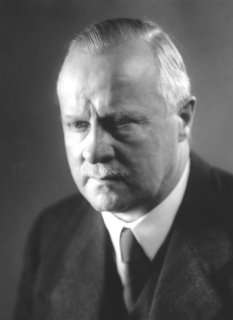Väinö Tanner
| Väinö Tanner | |
|---|---|
 | |
| 14th Prime Minister of Finland | |
|
In office 13 December 1926 – 17 December 1927 | |
| President | Lauri Kristian Relander |
| Preceded by | Kyösti Kallio |
| Succeeded by | Juho Sunila |
| Personal details | |
| Born |
12 March 1881 Helsinki |
| Died |
19 April 1966 (aged 85) Helsinki |
| Political party | Social Democratic Party |
Väinö Tanner (12 March 1881 – 19 April 1966; surname until 1895 Thomasson) was a leading figure in the Social Democratic Party of Finland, and a pioneer and leader in the cooperative movement in Finland. He was Prime Minister of Finland in 1926–1927.[1]
Tanner was born in Helsinki. He did not participate in the Finnish Civil War, maintaining a neutral attitude. When the war ended he became Finland's leading Social Democratic Party (SDP) politician, and a strong proponent of the parliamentary system. His main achievement was the rehabilitation of the SDP after the Civil War. Väinö Tanner served as Prime Minister (1926–1927), Minister of Finance (1937–1939), Foreign Minister (1939–1940), and after the Winter War Minister of Trade (1940–1942).
Väinö Tanner's legacy is in his directing the Finnish working class from the revolutionary ideal towards pragmatic progress through the democratic process. Under his leadership the Social Democrats were trusted to form a minority government already less than 10 years after the bloody civil war. Tanner’s minority socialist government passed a series of important social reforms during its time in office, which included a liberal amnesty law, reduced duties on imported foods, and pension and health insurance laws.[2]
During President Relander's brief illness Tanner, who held the post of prime minister, was even the acting President and Commander-In-Chief. In this role he even received the parade of the White guards on the 10th anniversary of the White victory. This was perceived as a remarkable development at the time. During the 1930s and 1940s, the Social Democrats formed several coalition governments with the Agrarian party (see, for example, Seppo Zetterberg et al., eds., A Small Giant of the Finnish History / Suomen historian pikkujättiläinen, Helsinki: WSOY, 2003). In the Winter War Väinö Tanner was the foreign minister. Väinö Tanner's leadership was very important in forming the grounds and creating the Spirit of the Winter War which united the nation.
After the end of the Continuation War, Tanner was tried for responsibility for the war in February 1946, and sentenced to five years and six months in prison.[3]
After the Continuation War, and while still in prison, Tanner became the virtual leader of a faction of the SDP which had strong support from the USA. This faction eventually came out on top after a great deal of internal party strife lasting for much of the 1940s.
References
- The Winter War: Finland against Russia 1939–1940 by Väinö Tanner (1957, Stanford University Press, California; also London)
- ↑ "Ministerikortisto". Valtioneuvosto.
- ↑ Democratic socialism: a global survey by Donald F. Busky
- ↑ Political Paavo, Time, December 6, 1948
External links
![]() Media related to Väinö Tanner at Wikimedia Commons
Media related to Väinö Tanner at Wikimedia Commons
- Väinö Tanner at Britannica Online
| Political offices | ||
|---|---|---|
| Preceded by Kyösti Kallio |
Prime Minister of Finland 1926–1927 |
Succeeded by Juho Sunila |
| Preceded by Juho Niukkanen |
Minister of Finance (Finland) 1937–1939 |
Succeeded by Mauno Pekkala |
| Preceded by Eljas Erkko |
Minister of Foreign Affairs (Finland) 1939–1940 |
Succeeded by Rolf Witting |
| Preceded by Rainer von Fieandt |
Minister of Supply (Finland) 1940–1940 |
Succeeded by Väinö Kotilainen |
| Preceded by Kaarlo Salmio |
Minister of Trade (Finland) 1941–1942 |
Succeeded by Uuno Takki |
| Preceded by Mauno Pekkala |
Minister of Finance (Finland) 1942–1944 |
Succeeded by Onni Hiltunen |
| Non-profit organization positions | ||
| Preceded by G. J. D. C. Goedhart |
President of the International Co-operative Alliance 1927 – 1945 |
Succeeded by Robert Palmer |

